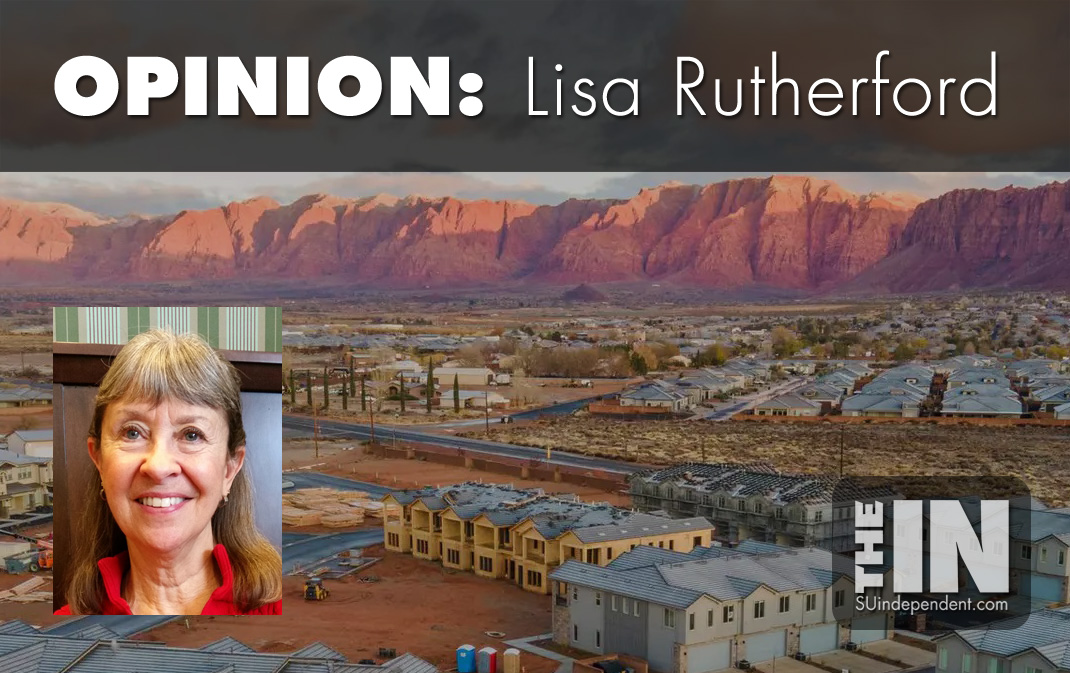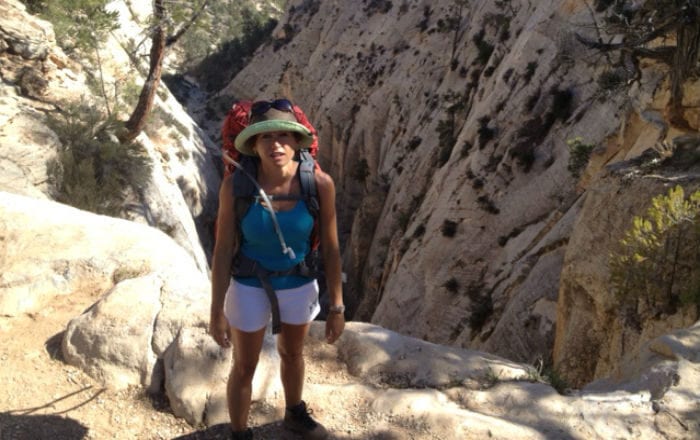
Ivins And Other Utah Communities Face Big Challenges
– By Lisa Rutherford –
Since 2006, I’ve battled growth-related issues such as the Lake Powell Pipeline and the Northern Corridor. Lately, my focus has been on air quality since air is critical to human health, particularly that of our most vulnerable. Growth brings good things, but it brings challenges other than water, air, and roads, too – massive development projects, housing affordability, short-term rentals, and bad decisions, to name a few.
Take my little – and growing! – town of Ivins. When I moved here in 2001, Ivins had a population of around 4,000. Now we are around 9,000, with 23,100 projected by 2050. Our current 9,000 does not include the thousands of visitors who come to enjoy Ivins’ amenities, including Snow Canyon State Park. Black Desert Resort, currently under construction, plans to bring 800,000 people annually to our city – or so the developer says – along with proposed LPGA and PGA events. It’s mindboggling and flies in the face of why many moved to Ivins.
Black Desert Resort was approved by our own officials, and it remains to be seen what effects that decision will ultimately have on this town. But decisions made by others are not helping this small town either. In 2021 the Utah Legislature passed House Bill 1003. This bill “prohibits a municipality or county from regulating certain building design elements” – effectively removing the right of cities to regulate visual components of development except for building height and exterior lighting in one- and two-family dwellings. This legislation was “sold” based on the need for “housing affordability” but has caused conflict in our city while doing little to help with high prices here due to land cost, an uncontrollable factor. It’s interesting that Utah lawmakers who complain about federal government overreach are not immune to doing it themselves. Apparently, they feel they can do it to their own Utah residents who must now live with their on-size-fits-all vision for Utah’s communities. Their “they voted us in and we make the decisions” mentality leaves citizens and local officials few if any options. Only one of our area’s legislators – Norman Thurston – voted against HB1003!
In the August Ivins City Newsletter Mayor Hart provided a great explanation of why he opposes the overreach by our Utah Legislature to undermine the decision-making authority of our city officials and other city/town officials throughout the state. We deserve to have our own officials making decisions that affect how our city looks and feels. Having some standards in a community protects property values. Many citizens who support this bill want to have a white house in a community that has built its reputation on southwestern styles and colors. We now have neighborhoods that are a hodgepodge of styles and colors based simply and apparently on what’s popular in the latest home-style magazines rather than what is suitable in this community that’s prided itself on a particular vision. Ivins has focused on colors that suit our natural surroundings. Some say that clouds are white so that’s “natural.” Well, yes, and lava is black, but do you really want a black house. Perhaps that will be the next preferred color. Or, perhaps Barbie will take over the home-style magazines and Ivins will be filled with Pepto-Bismol pink houses with some explaining that pink is natural to the area, too: just look at that sunset!
Governor Cox has focused on affordable housing for several years, but his desire that “free markets” should provide the solution has not worked. And Utah’s Republican-controlled Legislature has supported the governor by working to remove approval roadblocks for developers in the belief that will result in more affordable homes. Governor Cox’ emphasis on affordable housing is well-intentioned, but our city officials should have a say on how that happens. For the legislature to approve HB1003 under the guise of affordable housing is not helping.
But housing design problems created by poorly-thought-out and developer-driven legislation are not the only challenges we face in Ivins and elsewhere. Short-term rentals have become a problem, too. A 2022 Ivins General Plan Survey, which was well advertised throughout the community, had a 52.7% response rate. The response rate was high and all citizens had an opportunity to participate; 4258 surveys were mailed and 2244 were returned. When respondents were asked “What type of development should Ivins encourage” and that included short-term rentals, 75.7% of respondents gave a negative rating. A majority of Ivins citizens who responded want this slowed or stopped. But decisions continue to be made that support short-term rentals such as the decision regarding a SITLA development that has citizen willing to go to court over it.
So, perhaps decisions by state legislators are not the only questionable ones being made. Ivins officials seem afraid to challenge SITLA because of what they term SITLA’s “nuclear option” of basically doing whatever they want in spite of community feelings. SITLA may have made some modifications to their original development plan, but those are not enough to assuage concerns of neighbors whose property values may be negatively affected. In fact, the city’s current General Plan seems to fly in the face of citizens’ objections to short-term rentals. Goal #4 of the General Plan is to “Develop Ivins City as a resort destination community.” Objectives to achieve that goal include, “Attract businesses and development that can service tourism” and “Encourage housing options that cater to tourism.” Both of these objectives seem to point decisions in the direction of more short-term rental approvals, not less. The General Plan does not indicate when enough is enough. So, exactly when will the city have achieved the goal of becoming a resort community? Some feel that with the addition of Black Desert, a huge development, that has already been achieved.
Besides short-term rentals, the SITLA development also ties into problems created by developers who have little concern for the effects they have on existing homes near their development. The SITLA parcel has high ground water issues that are well-known and citizens are concerned about what that development could do to the water problem and its effect on their property. Other developers have caused problems due to vibration that damages nearby homes, but home owners have little if any recourse. How can the city protect existing homeowners while allowing development, development that the state seems to be encouraging? Existing homeowners’ rights and property protection should be city officials’ main concern but that does not seem to be the case.
The Ivins General Plan, current as of August 2015, states a desire to “Preserve a unique community that reflects the serenity of its natural surroundings.” Right now, there does not seem to be much “serenity” for many in Ivins, and our “unique community” is certainly at risk, while the development lobby and associated greed are in the driver’s seat. Ivins faces significant challenges as we work to protect what we have while meeting the need for affordable housing, too. Are we up to it?
Viewpoints and perspectives expressed throughout The Independent are those of the individual contributors. They do not necessarily reflect those held by the staff of The Independent or our advertising sponsors. Your comments, rebuttals, and contributions are welcome in accordance with our Terms of Service. Please be respectful and abide by our Community Rules. If you have privacy concerns you can view our Privacy Policy here. Thank you!
Click here to submit an article, guest opinion piece, or a Letter to the Editor





This article should be mandatory reading for local government officials in Wa County caught in the fray of the current paradigm of accelerated development. Not whether there would be agreement or disagreement amongst those willing to read this article, rather it provides a fair assessment of the predicament and also raises the bar in terms of understanding “the big picture”.
We may have the same problem in Brian Head where there are unsightly abandoned foundations where there were good intentions and a road to “no-where” with no development. There were also promises in the “Trails of Navajo” development that were never kept.
Thanks to those who read and comment on my articles. I enjoy reading what is on the minds of others.
Ms. Rutherford, I enjoy the way you investigate matters, so I have one for you that I would love to hear your response. Being as I consider Ivins to be out of control on Building and overtaking our resources, I have been looking into “Open Land Preservation ” and “Conservation Easement”, as I think these, or some other forms, may be the answer to out of state developers coming into our town and purchasing land to develop, bring in more bodies using our limited resources. Thank you for checking this out for us.
James Barden
“mikebarden239@gmail.com”